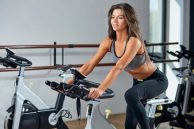
Are you ready to take your indoor cycling workouts to the next level? Whether you’re a seasoned cyclist or just starting out, establishing a pre and post-ride routine is key to maximizing your performance and reaping the full benefits of your indoor cycling sessions. In this comprehensive guide, we’ll delve into the essential steps to take before and after your indoor cycling workout. Get ready to elevate your indoor cycling experience and achieve your fitness goals like never before!
Preparing for an Indoor Cycling Workout
Before you hop on your exercise bike, it’s crucial to adequately prepare your body and mind. Let’s explore the essential steps to take before your indoor cycling session.
Hydration and Nutrition
To fuel your body for optimal performance, ensure proper hydration by drinking water before your workout. Additionally, consume a balanced meal or snack that provides carbohydrates for energy and a source of protein to support muscle recovery.
Warm-Up Routine
Prepare your muscles and joints for the intensity of your indoor cycling workout with a warm-up routine. Incorporate dynamic stretching exercises to activate your muscles and increase your range of motion. Follow it up with light cardiovascular exercises like jogging or jumping jacks to gradually increase your heart rate and blood flow. Finally, perform mobility exercises that focus on key cycling muscles and joints, such as leg swings and hip rotations.
Checking Your Exercise Bike and Gear
Before you start pedaling, take a moment to inspect your exercise bike. Ensure that the seat is properly adjusted to your height and that the handlebars are at a comfortable position. Check the security of the pedal straps or, if you have clip-in pedals, verify that your cycling shoes are securely attached.

Image source from Sunny Health & Fitness.
Recommended Products: Sunny Health & Fitness Pro Indoor Stationary Bike
Mental Preparation
Setting intentions and goals before your indoor cycling workout can have a profound impact on your performance. Visualize yourself conquering the workout, staying motivated, and pushing through challenges. Boost your confidence and motivation through positive self-talk, reminding yourself of your capabilities and the rewards of your hard work.
During Your Indoor Cycling Workout
Once you’re on your exercise bike, there are several factors to consider to optimize your performance and ensure a safe and effective workout. Let’s explore what you should focus on during your indoor cycling sessions.
Proper Bike Setup and Posture
Proper bike setup is crucial for comfort and injury prevention. Adjust the seat height so that your legs have a slight bend when the pedal is at its lowest position. Maintain correct riding posture by keeping your back straight, shoulders relaxed, and arms slightly bent. This alignment promotes efficient pedalling and minimizes strain on your joints.
Cadence and Pedaling Technique
Find your optimal cadence, which is the number of pedal revolutions per minute. Strive for a cadence that allows you to maintain a steady and controlled pace without excessive bouncing or feeling too heavy on the pedals. Focus on smooth pedalling technique, utilizing a full pedal stroke by pushing down with your quads, pulling up with your hamstrings, and engaging your glutes and calves.
Breathing and Rhythm
Pay attention to your breathing during your indoor cycling workout. Practice deep breathing techniques to support oxygen flow and energy production. Establish a rhythmic cadence that matches your pedaling, helping you maintain a steady and efficient pace. Syncing your breathing with your pedal strokes can improve your overall cycling experience.
Monitoring Intensity and Effort
Listen to your body and adjust the intensity of your indoor cycling workout accordingly. Perceived exertion can guide you in gauging your effort level. Scale your intensity based on how hard you feel you’re working, considering factors such as your heart rate, breathing rate, and the amount of resistance or speed you’re utilizing. Always prioritize safety and avoid overexertion.
What to do after cycling workout – Post-Ride Recovery and Care

After completing your indoor cycling workout, it’s essential to prioritize proper recovery and care for your body. Let’s explore the essential steps to take post-ride.
Cooling Down
Gradually lower your heart rate and bring your body to a state of rest by pedaling at a gentle pace for a few minutes. Follow it up with a cooldown stretching routine to enhance flexibility and release any muscle tension. Focus on stretching your calves, quads, hamstrings, hips, and lower back.
Hydration and Nutrition
Replenish your body by hydrating with water or a sports drink to replace fluids lost during your workout. Consume a post-workout snack or meal that combines carbohydrates and protein to aid in muscle recovery and repair.
Recommended Reading: Best Whey Protein For Athletes & Fitness Enthusiasts
Foam Rolling and Self-Massage
Relieve muscle tension and soreness by incorporating foam rolling and self-massage into your post-ride routine. Target key areas such as your legs, hips, and back. Roll slowly and focus on areas that feel tight or tender, applying gentle pressure to release any knots or trigger points.
Rest and Active Recovery
Allow your body to rest and recover by taking time to relax and rejuvenate. Adequate rest is crucial for your muscles to repair and rebuild. You can also incorporate active recovery activities such as gentle walking, yoga, or light stretching to promote blood circulation and facilitate muscle recovery.
Mental Reflection and Goal Setting
Indoor cycling is not just a physical activity but also a mental one. Taking time to reflect on your ride and set new goals can contribute to your overall growth as a cyclist.
Reflecting on Your Ride
Evaluate your performance and enjoyment during your indoor cycling workout. Reflect on what went well and areas where you can improve. Celebrate your accomplishments and take note of any adjustments you can make for future rides.
Setting New Goals
Set new goals to keep your motivation high and continue progressing in your indoor cycling journey. Establish both short-term and long-term goals that are specific, measurable, achievable, relevant, and time-bound (SMART). Write them down and track your progress as you work towards accomplishing them.
Conclusion
By implementing a pre and post-ride routine, you can optimize your indoor cycling workouts, enhance your performance, prevent injuries, and promote overall fitness and well-being. Remember to hydrate, fuel your body, warm up adequately, and prepare your mind before your ride. Afterward, prioritize proper recovery and care through cooling down, stretching, replenishing fluids, and taking care of your muscles. By incorporating these practices, you’ll elevate your indoor cycling experience and achieve your fitness goals with confidence and satisfaction.
So, before you hop on your exercise bike for your next indoor cycling session, remember the significance of what you do before and after your ride. Your dedication to these routines will contribute to a rewarding and successful indoor cycling experience!
Further readings and references:
- The benefits of stationary bike
- Hospital for Special Surgery (HSS) – How to Set Up an Exercise Bike Properly
- J Exerc Rehabil. 2017 Aug; 13(4): 400-404 – Effects of 16-week spinning and bicycle exercise








